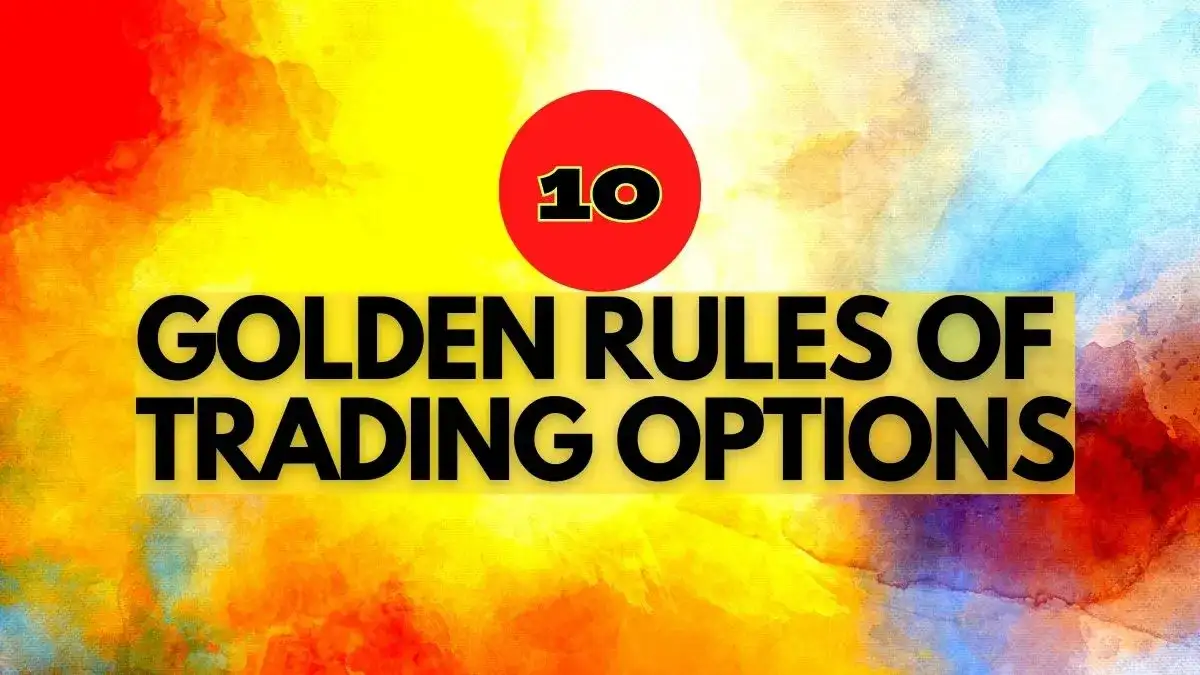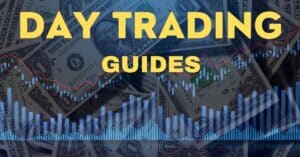- Introduction
- Rule #1: Understand the Strike Price
- Rule #2: Master the Expiration Date
- Rule #3: Avoid the Naked Position
- Rule #4: Know the Option Greeks
- Rule #5: Keep an Eye on Time Value
- Rule #6: Be Mindful of Holidays
- Rule #7: Manage Emotions
- Rule #8: Practice Risk and Money Management
- Rule #9: Understand ITM, ATM & OTM Options
- Rule #10: Hedge Your Trading Positions
- Frequently Asked Questions (FAQ)
- Conclusion
Introduction
Trading options can be a thrilling way to make money, but knowing that risks are involved is essential. Just like any investment, you can lose money. In this article, we’ll discuss these 10 golden rules of trading options in simple terms to help you achieve long-term success.
By learning and applying these trading rules, you can become a successful options trader as a buyer or seller.

Rule #1: Understand the Strike Price
As an options trader, understanding the concept of the strike price is very important to making profitable trades. The strike price is when the underlying asset can be bought or sold in the options contract. It’s important to understand how market volatility affects an option’s value and how to use this knowledge to your advantage
Key factors to consider when selecting a strike price:
- Your outlook on the underlying asset: To choose a call or put option, you need to have a clear view of the direction in which you believe the underlying asset will move. This will help you determine whether to go with an in-the-money (ITM), at-the-money (ATM), or out-of-the-money (OTM) option.
- Your risk tolerance: It’s important to consider your risk tolerance before selecting a strike price. While OTM options are cheaper and riskier, you should decide how much risk you’ll take.
- The expiration date: The expiration date of the options contract can impact your choice of the strike price. If the expiration date is far in the future, you might want to choose a strike price further from the underlying asset’s current market price. However, if the expiration date is approaching soon, you might prefer a strike price closer to the current market price to reduce the risk of the option expiring worthless.
- Volatility: Higher volatility often leads to higher option premiums, which may make it more expensive to choose a strike price that is further from the underlying asset’s current market price. Lower volatility, on the other hand, may make it more attractive to choose a strike price closer to the current market price of the underlying asset.
- Market conditions: You should read the current market conditions when you choose a strike price. In a trending market, for example, it may be more attractive to choose a strike price further from the current market price of the asset, as the trend is expected to continue. However, in a range-bound market, it’s safer to choose a strike price closer to the underlying asset’s current market price.
Rule #2: Master the Expiration Date
The expiration date is a make-or-break factor in the high-risk world of options trading. So, failing to understand its significance could spell disaster for your financial health. The expiration date is the date on which an option contract expires, rendering it worthless after that point. Understanding the significance of expiration dates is essential for successful option trading. Having a well-defined strategy in place can bring you closer to your trading goals.
Effect on Option Prices
One of the primary reasons why the expiration date is critical is its effect on option prices. As the expiration date approaches, the time value of the option decreases. So, it results in a corresponding decrease in the premium. Holding an option for too long, therefore, can result in a decline in its value over time. This makes it imperative to keep track of your options’ expiration dates and to determine whether to roll over the position, take profits or losses, or close out the position entirely.
Lasting of Trades
The expiration date also affects how long the trade lasts. Options with longer expiration dates allow more time for the underlying asset to move in the desired direction. It potentially increases the option’s value. However, this also means higher premiums and increased risk. Conversely, shorter expiration dates may require a strike price closer to the current market price, while longer expiration dates may require a strike price further from the current market price.
In addition, the expiration date can influence the level of volatility in the option’s price. As the expiration date gets closer, the option’s price may become more volatile, which can increase the premium.
This can be advantageous if the underlying asset moves in the desired direction, but it can also amplify the risk of the trade.
Rule #3: Avoid the Naked Position
One of the most important rules in options trading is to avoid taking a naked position. Selling a call or put option without owning the underlying security is called a “naked” position. It can lead to unlimited losses and is not recommended for novice traders. Only experienced traders should try this risky strategy of earning profits from the premium.
Risk of Market Moves Against the Trader
One of the main risks of a naked position is that if the market moves against the trader, the losses can quickly spiral out of control. For example, if a trader sells a call option on a stock that they do not own and the stock price rises sharply, this can result in significant losses and even wipe out an entire trading account.
To avoid the risks of a naked position, it is essential to have a solid risk management strategy in place. To avoid losing too much money, traders can use strategies like stop-loss orders, option spreads, or not trading without protection.
In addition to selling naked options, it’s important to note that buying naked options can also be risky. A naked call option is when a trader buys a call option without owning the underlying asset, while a naked put option is when a trader buys a put option without owning the underlying asset.
Risk of Losing the Entire Premium
Buying naked options can be appealing since it has the potential for big profits with a small investment. However, it also comes with a high level of risk. The value of the option can decrease rapidly if the underlying asset doesn’t move in the desired direction or if there is a significant change in market conditions.
Buying naked options requires paying a premium, which can be a large sum based on the strike price and expiration date of the option. If the option expires out of money, the entire premium paid for the option is lost.
Therefore, it’s important to be cautious when considering buying or selling naked options. New traders should avoid naked options. Instead, they should focus on conservative strategies. Examples include owning the underlying asset or using option spreads. These can help minimize potential losses.
Experienced traders who do choose to trade naked options should do so with a thorough understanding of the risks involved and a solid risk management plan in place.
Rule #4: Know the Option Greeks
The option Greeks—delta, gamma, theta, vega, and rho—are measurements that show how different things, like the price of the asset, time, how much it changes, and interest rates, can affect the price of an option. Understanding the Greeks is critical for managing risk and maximizing profits in options trading.
Delta measures how an option’s price will change in response to changes in the underlying asset’s price. Gamma measures the rate at which the delta changes as the underlying asset price moves. Theta measures the rate of time decay, or how much an option’s price will decline as it approaches its expiration date. Vega measures the sensitivity of an option’s price to changes in volatility. However, the rho measures the sensitivity of an option’s price to changes in interest rates.
With a deeper understanding of the Greeks, traders can make more profitable decisions about when to enter or exit trades. This could effectively manage their positions. For example, a trader who understands theta’s impact on an option’s price may avoid holding options too close to their expiration date. Traders who grasp the relationship between delta and gamma may use delta-neutral strategies to control their risk.
Rule #5: Keep an Eye on Time Value
To make money and avoid losing it, options traders must know how to work with time value. In options trading, time value refers to the extra amount an option buyer pays for the opportunity to profit from an asset’s price movement.
Time Decay
As the option’s expiration date gets closer, the time value decreases, leading to time decay. This can erode an option’s value over time, even if the underlying asset price remains stagnant.
To avoid losses due to time decay, traders must keep a close eye on the option’s theta. Theta measures the rate of time decay. By using this tool, traders can better understand how much an option’s value is likely to decrease as it approaches its expiration date.
Volatility and Trade Adjustments
It is important to monitor volatility because options with higher volatility typically have a higher premium. Hence, traders may need to adjust their positions or exit trades if volatility changes significantly with an option’s time value.
Knowing about time value is important for options traders because it helps them decide when to enter or exit trades. Traders can use theta to monitor time decay and make smart decisions about when to enter or exit trades. This can help them minimize losses and potentially maximize profits.
Traders need to watch time decay and adjust their positions accordingly. They should avoid assuming that an option’s value will always increase over time. Ultimately, mastering time value is an essential skill that can set traders apart in the options market.
Rule #6: Be Mindful of Holidays
The holidays are a time for fun and relaxation, but for options traders, they can be a time of chaos and mayhem. Holidays can be good for those who write options because they can make money without worrying about sudden changes in the market.
They can sit back and relax without any fear of unexpected price movements that could result in losses. But, for option buyers, the holidays can be a challenging time as they face wider bid-ask spreads and reduced liquidity. This always makes it harder to earn profits from buying options.
Holidays can cause options to lose significant value through time decay. This can come as a nightmare to buyers and lead to unforeseen losses. This means that option buyers must be extra cautious during the holidays and avoid buying fresh options. Failure to do so can result in significant losses, putting their financial stability at risk.
Option writers can enjoy the reduced risk, but option buyers need to be extra cautious and prepared for the potential challenges that come with a holiday-shortened trading week. Being aware of the low volatility and faster premium erosion can help traders make better decisions and increase their chances of success.
Don’t let the holidays be a time of chaos for your options trading; be prepared and make the most of the opportunities that come with them.
Rule #7: Manage Emotions
Futures and options trading is not for the faint of heart. The high stakes and fast-paced nature of the markets can trigger a range of emotions, from the euphoria of a profitable trade to the fear of losing big. However, successful traders know that emotions like greed and fear can be their downfall if left unchecked.
To do well in trading, traders should be good at controlling their feelings and have self-control. This means having a rock-solid trading plan and sticking to it, even in the face of emotional impulses. It also means understanding and managing risk effectively so that fear and greed don’t cloud judgment.
Stop-loss orders are one powerful tool traders can use to manage emotions and limit potential losses. By setting a predetermined exit point for a trade, traders can take the emotion out of the decision-making process and focus on their long-term strategy.
However, managing emotions goes beyond just using tools and techniques. It also means taking care of oneself and being mindful of the impact emotions can have on decision-making. Taking breaks and practicing stress-reducing techniques like meditation can help traders stay emotionally balanced and focused.
By having these skills, traders can have a better chance of success and feel confident about trading in the futures and options markets.
Rule #8: Practice Risk and Money Management
Risk management and money management are essential for successful options trading. To minimize risks when trading, it’s important to decide how much to invest, avoid leveraging too much, set limits on potential losses, and have a plan for managing profits and losses.
Before making any option trade, traders need to consider their risk tolerance, the amount of money in their account, and the current market conditions to decide on the appropriate trade size. It is important to never risk more than 3% of your trading account on any single option trade.
When buying options, it’s essential to pay a fair price based on the market. Traders should also set a limit on how much they’re willing to lose by using stop-loss orders. When selling options, traders need to choose the right strike price and expiration date and also use stop-loss orders like the buyers.
To be successful in options trading, traders need to have a proper plan for when to exit a trade and take profits, as well as when to cut their losses. They also need to keep a watchful eye on the market and be ready to adjust their strategies if necessary.
Rule #9: Understand ITM, ATM & OTM Options
To make money in options trading, it is crucial to understand the concepts of ITM, ATM, and OTM options. If you’re selling or writing options, you can use the ITM, ATM, and OTM concepts to your advantage.
Buying and Selling ITM Options
When you buy an ITM option, you are paying a premium for the intrinsic value, hoping that the price of the underlying asset will move in your favor. However, if the price doesn’t move as expected, you can lose money quickly.
Selling ITM options can provide a steady income stream but also comes with significant risks if the price of the underlying asset moves against you.
Buying and Selling ATM Options
An ATM option has little to no intrinsic value and is priced based on its time value. Buying an ATM option means you’re betting that the price of the underlying asset will move significantly in one direction, but if it remains stable, you can quickly lose money.
However, selling ATM options can provide a balance between risk and reward.
Buying and Selling OTM Options
OTM options have no intrinsic value and are priced solely based on their time value. Buying an OTM option means you’re paying a premium for the possibility that the price of the underlying asset will move significantly in one direction. However, if it doesn’t move as expected, the option can quickly lose value and become worthless.
Selling out-of-the-money (OTM) options can give you a higher potential profit, but it also comes with a higher risk of loss if the price of the underlying asset moves against you.
Rule #10: Hedge Your Trading Positions
Hedging is similar to wearing a helmet while riding a bike; it shields you from potential harm. Options trading is a method to reduce risks and potential losses. Options are commonly used to safeguard investments from possible losses. In the past, professional investors like hedge funds used options to protect their portfolios. Nowadays, regular people who trade and invest are also using options as a way to make money.
There are two types of hedging: long and short. A short hedge is when an investor buys a put option. This is useful when they think the value of the underlying stocks will decrease quickly. A long hedge is when an investor takes a long position and buys a call option. This helps offset potential losses by balancing out profits on different instruments.
Hedge Your Cash Portfolio
If you own a stock portfolio, you can lower the risk of potential losses by trading options. Traders sell call options on assets they hold to shield themselves from market selling pressure, which helps minimize damage to the portfolio. Alternatively, buying put options on stocks held in the portfolio can also reduce the risk of significant selling pressure in the market.
In a market where stock prices move within a certain range and your portfolio isn’t performing well, you can sell call options on those stocks. Selling options at a premium allows you to earn steady profits.
Hedge your Option Portfolio
For instance, imagine you’re bullish on a particular stock. You buy a call option, expecting its price to increase. However, if the stock’s price moves against your expectations, the call option’s entire premium could erode, resulting in losses. To protect against this scenario, you could simultaneously buy a put option, which can balance out the loss of the call option.
By implementing this strategy, you’ve created a long strangle. This can potentially limit your losses if the stock’s price moves unexpectedly. It’s important to note that hedging is not always a foolproof method and comes with a set of risks. Often, hedging can provide a safety net for your options trades, but it is important to understand that it does not guarantee complete protection.
Hedging is also necessary for option writing or when you intend to sell options. Naked option selling can never be the safest, though the majority of the time, option prices tend to decay. To hedge option writing, one can adopt an option spread strategy.
Imagine you’re hopeful about the market going up but want to protect yourself from big losses if things don’t go as planned. In this case, you can use a bullish vertical spread. This means you buy a call option at one strike price and sell another call at a higher strike price, both with the same expiration date. This strategy can help you maximize your profits while minimizing your losses.
There are many other strategies that options traders can use to protect themselves against potential losses
Frequently Asked Questions (FAQ)
Is option trading profitable?
Yes, options trading can be profitable if you follow strict rules and implement proper risk management strategies.
Is option trading gambling?
No, options trading is not gambling. It’s a legitimate profession that requires knowledge, skills, and discipline.
Is option trading worth it?
Yes, options trading can be worth it if you have the right mindset and approach it as a serious business or investment opportunity.
Can options trading make you rich?
Yes, options trading can potentially make you rich, but it’s important to remember that it’s a high-risk game, and success is not guaranteed.
Is option trading legal in India?
Yes, options trading is legal in India. You can trade in options like equity if you have a trading account enabled for the F&O segment.
Is option trading good for beginners?
No, options trading is not recommended for beginners. It’s a complex and risky trading strategy that requires years of experience and expertise.
Where do I learn about options trading?
You can learn options trading through books, web portals, YouTube channels, and personal mentorship from experienced traders.
Where can I do options trading?
You can do options trading on any platform provided by brokers that offer options trading facilities.
Conclusion
Options trading can be lucrative if you do it right. Use hedging strategies, avoid naked positions, and always have a solid risk management plan. Remember to analyze the market carefully and adjust your trading strategies when needed. By following these rules, you can become a successful options trader and achieve your financial goals.




